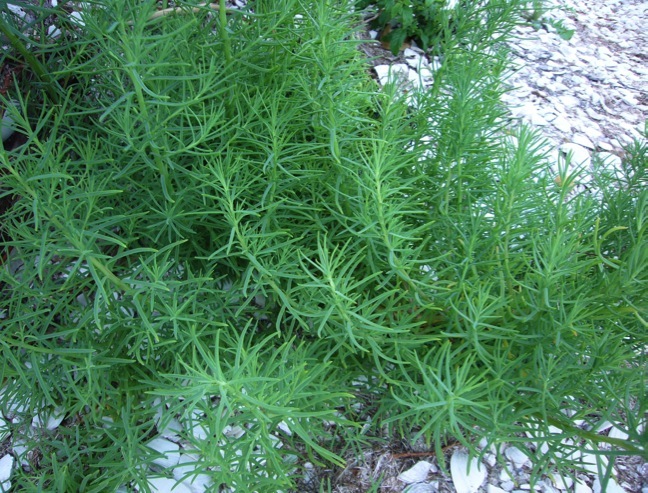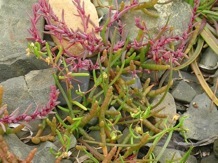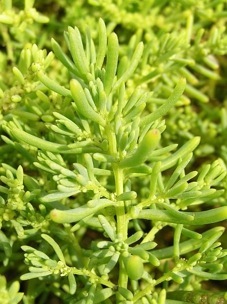Suaeda linearis, maritima: Edible Blite
While most people find Sea Blite next to the sea, I find Sea Blite on the other side of the barrier island, on the inland coastal waterway. Actually, Sea Blites, Suaedas, can turn up in the strangest of places.
The Southern Sea Blite, Suaeda linearis, (above) is found on the coast from Texas to Maine but not quite to Canada. The Annual Sea Blite, Suaeda maritima, (right) is found from Virginia north into eastern Canada but also two western counties in Florida, a county in the middle of Kentucky, one northern county in Washington, southern Alaska, and Manitoba. Suaeda californica, a marsh plant, is found in four counties in California and is not pictured because it is quite rare. Suaeda calceoliformis, the Pursh Seepweed is found peppered about all of North American except the old South, Iowa and Vermont. Formerly called S. depressa, it is no doubt in more places than that for the government maps are often decades out of date. Also edible in western North America are S. nigra, S. occidentalis, and S. palmeri. Elsewhere in the world they eat S. australis, S. corniculata, S. fruiticosa, S. glauca, S. japonica, and S. salsa. In some areas the Suaeda is common, in others rare, so check out your local form and condition. Generally said, when a plant in the Suaeda genus is near the ocean it is a Sea Blite, when near salty water or land elsewhere, it is a Seepweed. All are related to the Chenopodiums if I remember correctly.
Suaeda is the Latinized version of the Arabic name for this genus, said soo-EE-duh. Linearis (lin-ee-AIR-iss) means narrow and maritima (mar-ih-TEE-muh) of the sea. Californica (kal-lee-FOR-ni-ka) means of California and calceoliformis (kal-see-oh-lee-FOR-mis) refers to the plant’s flower that is shaped like a little shoe. Pursh is probably for Frederick Traugott Pursh (1774 -1820) a German-American botanist. Blite came from Blight which is a discoloring. S
S. californica and S. calceoliformis were eaten by western Indians, usually the young shoots and leaves, often combined with cactus. The seeds and leaves of the S. Linearis are eaten. Young shoots of the S. maritima are the prime edible of that plant, lightly steamed. Generally said inland version prefer salt lick areas and the like. As with many salt-tolerating plants, they often become tinged with red sometime in the season. While they can be eaten on their own, which sometimes requires boiling twice in fresh water to reduce the salt, they are also used as flavoring with other plants. Young shoots can also be picked as used alone or eaten as a relish.
Imported from Europe, the Suaeda maritima is a bushy coastal annual, pale green with a whitish cast. Leaves narrow or almost cylindrical, long and fleshy. It has pale green flowers, blooming from July through October. You’ll find it dotting the higher parts of the beach. It can grow in gravel, sand, among rocks and around boulders. It’s a soft plant, often low-growing. The leaves are tiny, round, and pointed, reminding one of a spruce. Yellow-green flowers can be found at leaf axils. It can be bitter when cooked.
Suaeda calceoliformis is an annual herbs, low to erect, green to dark red,hairless, stems crawling to erect, green to dark red, usually striped, simple or branched. Leaves narrow, flatish. Flowers irregular, seeds like a tiny lentil, brown, dull. Flowers summer through fall, found in salty soils also around salted roads, salt piles, salt lakes et cetera.
Sea Blite is one of those plants that when you taste it your ancient food-detecting systems says “this is real food.” A lot of wild forageables are an acquired tastes. Fortunately Sea Blite, particularly S. Linearis, has the taste and texture of good food. I am surprised it is not mentioned more often and it should be a commercial crop. Its great green prime here in Florida starting around March.
Green Deane’s “Itemized” Plant Profile
IDENTIFICATION: Suaeda linearis, annual or perennial herb to three feet tall, branched, succulent, light green to almost white stems, leaves narrow, pointed, triangle shaped, almost, fleshy, to two inches long. Flowers have five lobes. Seed is glossy black, small.
TIME OF YEAR: Flowers August to September, seeds September to October
ENVIRONMENT: Salt marshes, beaches, dunes,
METHOD OF PREPARATION: Leaves and stems refreshing to quite salty, depending on where collected and when, but can be eaten raw or cooked, sometimes requires a change of boiling water. It is absolutely excellent boiled. Boiled first-year tips are delicious and if known better would lead to the plant’s extinction. Can be used as a flavoring for other foods, seeds can be ground into mush or used to make bread.
Sea Blite and Sour Cream Salad
Four cups Sea Blite leaves, stems, or flowers, cooked, drained and chopped.
One tablespoon sugar
One cup sour cream
Three tablespoons grated onion
Two tables spoons vinegar or lemon juice
Two hard-cooked eggs, diced
Salt optional
Blend all ingredients and chill for two hours before serving. Serves four to six.
Garnished Sea Blite
Four cups chopped Sea Blite
Six slices of bacon, chopped and friend crisp
Two tablespoons grated cheese, such as Parmesan
Two tablespoons vinegar, preferable a wine or light vinegar.
Boil or steam the Sea Blite. Drain and combine with remaining ingredients. Add some bacon fat if desired. Serve hot, serves four.
Sea Blite Chicken Soup
Two chicken breasts
Two quarts of water
One cup of Sea Bite leaves, washed and chopped
Three carrots diced
Two scallions chopped
Two celery stalks chopped
1/4 teaspoon each rosemary, thyme, and parsley flakes
One clove of garlic minced, or to taste.
One half cup Parmesan cheese or the like.
Boil the chicken in water for 30 minutes, remove chicken and cut into bite-size pieces, add all ingredients but cheese to the water and cook 45 minutes. Add cheese, serve.




